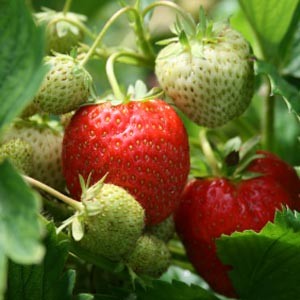Sorenne was quick to the fruit at the compact market in Melbourne tonight: 2 punnets of strawberries.
 She gets it from her father, who got it from his mother, except the strawberry season in Australia is almost year round, while in Ontario, it’s five weeks.
She gets it from her father, who got it from his mother, except the strawberry season in Australia is almost year round, while in Ontario, it’s five weeks.
I do love my berries.
I’m not alone: according to statistics published by the United States Department of Agriculture and cited in the New York Times, percent since 2000.
But if you compare apples and oranges, you’ll find we now eat 9 percent less of each, and 11 percent fewer bananas. The decline in those three mainstays, which still account for 49 percent of the fresh fruit we eat, has made room in our diets for more berries, pineapples (up 99 percent), mangoes (up 42 percent), papayas (up 41 percent), tangerines (up 40 percent), lemons (up 56 percent) and avocados (up 139 percent), which, yes, the agriculture department says are fruit.
per capita consumption of fresh raspberries grew 475 percent from 2000 to 2012, the most recent year for which data are available. Blueberry consumption is up 411 percent, and strawberries are up 60 percent.
Before you pat yourself on the back for your healthy eating habits, you should know you’re probably not eating a lot more fresh fruit in total: The latest reading is 48 pounds per person per year, up just 1
If people are eating more of some kind of fruit, it’s probably because farmers have figured out how to deliver more of it, at higher quality, throughout the year.
 Of course, there is the “superfood” factor: Both raspberries and blueberries have been praised for their nutrient value. But Chris Romano, who leads global produce procurement for Whole Foods, attributes the boom in berries largely to taste and availability.
Of course, there is the “superfood” factor: Both raspberries and blueberries have been praised for their nutrient value. But Chris Romano, who leads global produce procurement for Whole Foods, attributes the boom in berries largely to taste and availability.
“Techniques in growing raspberries, blueberries and blackberries have gotten much better over the last 15 years,” he said. Growers are planting better breeds of berry, with higher sugar content; they’re using pruning and growing techniques that extend the season, including growing berries inside greenhouse-like structures called tunnels that retain heat; and most important, they’re growing berries in places they didn’t used to, where production is possible at different times of year.
 Historically, blueberries needed to be grown in regions that get cold weather for part of the year, because rising temperatures bring the plants out of dormancy. But newer “low-chill” blueberry varieties have helped make berries available all year by expanding production to formerly inappropriate areas like coastal California. That helps make more berries available in months like November.
Historically, blueberries needed to be grown in regions that get cold weather for part of the year, because rising temperatures bring the plants out of dormancy. But newer “low-chill” blueberry varieties have helped make berries available all year by expanding production to formerly inappropriate areas like coastal California. That helps make more berries available in months like November.
While the U.S. imports many of its fresh fruits, Australia is its own island.
So much so that on my flight back from Japan the other day I was sitting beside a 21-year-old Japanese kid who was going to pick fresh strawberries in Bundaberg (north of Brisbane), because it was that lucrative (and they probably can’t get locals to do the work).
Food safety, and microbial transmission are increasingly international.

 said.
said. I edit three of the four daily
I edit three of the four daily  We gave talks all over the world, for various groups, including the National Restaurant Association, Walt Disney World, and dozens of public health groups and scientific societies.
We gave talks all over the world, for various groups, including the National Restaurant Association, Walt Disney World, and dozens of public health groups and scientific societies. 
 Or contact me directly,
Or contact me directly, .jpg) If you
If you .jpg)